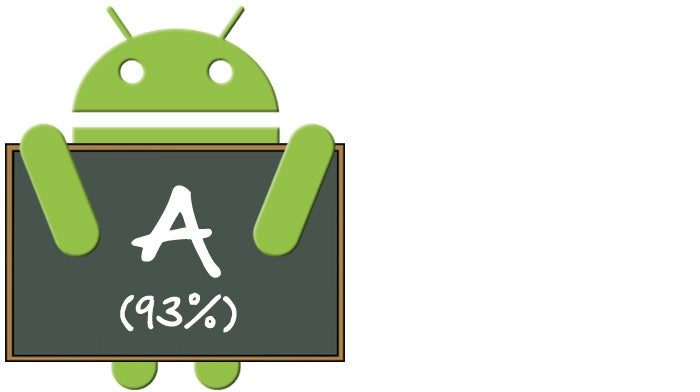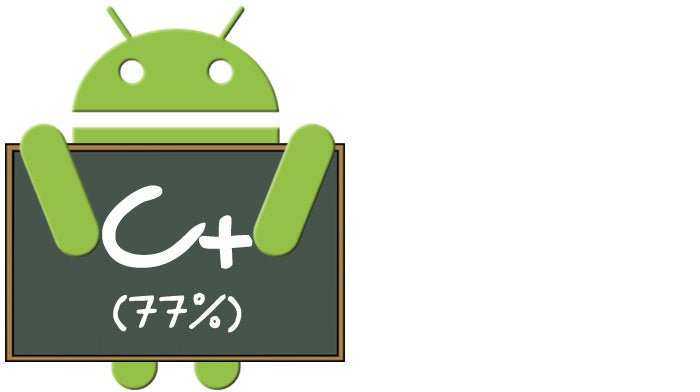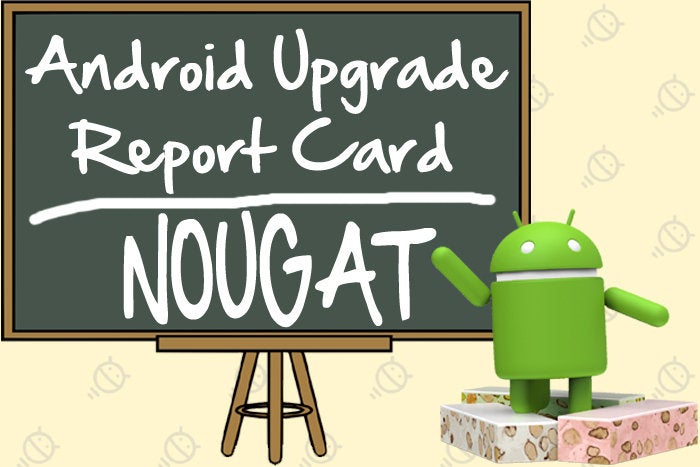'Tis the season for tech companies to start hawking high-end phones. Over the coming weeks and months, we'll be hearing about numerous new Android devices from practically every manufacturer imaginable.
One thing you can bet none of them will mention, though, is their commitment -- or lack thereof -- to supporting and updating those smartphones after you buy 'em. Plain and simple, that's not something most Android device-makers like to draw attention to or discuss.
Don't let that lack of focus fool you. A company's commitment to timely and ongoing software support is arguably the most important thing to consider with any Android phone purchase. The problem is that it's hard to know what to expect when manufacturers aren't upfront about their policies.
I'm here to help. I've been tracking Android manufacturers' commitments and performance with OS upgrades since the platform's earliest days -- and this year is no exception.
After all, while Google's deconstruction of Android and introduction of standalone security patches have helped make traditional updates less critical than they once were, our devices still have significant foundational improvements that only full OS upgrades can provide. Timely ongoing upgrades aren't everything, by any means, but they are without a doubt a significant and valid factor to consider.
So let's arm ourselves with knowledge, shall we? We've now reached the point where we're six months past the launch of the most recent major Android release, Android 7.0 Nougat -- and that means it's prime time to step back and look at who's making post-sales support a priority and who's treating it as an afterthought.
This Android upgrade cycle is especially interesting, as Google took the unusual step of introducing a preview version of Nougat all the way back in March of 2016 -- nearly three months earlier than it had with the previous year's release. It then delivered the final version of the software in August, a month and a half ahead of its 2015 schedule. All in all, that gave Android device-makers a full 36 more days with the software ahead of its release than they'd had with both of the previous two (Marshmallow and Lollipop) cycles.
You'd think that would mean the scores this go-round would be higher than ever. But -- well, that isn't exactly how things panned out.
Enough with the suspense. Time to see who's making the grade and who's coming up short.
(Want the full nitty-gritty on how these grades were calculated? You can find a detailed breakdown of the formula and every element taken into account at the very end of this article.)
 jr
jr- Length of time for upgrade to reach current flagship: 0 days (60/60 points)
- Length of time for upgrade to reach previous-gen flagship: 42 days (27.6/30 points)
- Communication: Mediocre (5/10 points)
With the Pixel, Google officially became a full-fledged Android phone manufacturer. But even before, with its Nexus devices, it played the same role as far as updates go -- acting as the sole provider of all rollouts and software-related matters.
And in an unusual twist, Nexus devices are actually the only ones that are relevant for this analysis. The Pixel didn't go on sale until October 2016, well after Nougat's debut -- a change from Google's typical approach of launching its flagship phone alongside its latest Android version. So for the purposes of this report card, we'll consider the Nexus 5X and 6P to be the "current" flagships and the Nexus 6 -- which came out way back in November of 2014, nearly two full years before Nougat's arrival -- to be the "previous-gen" model.
The results are mostly good, though not perfect: At least some owners of the 5X and 6P received updates on the first day of Nougat's release, when Google started its Android 7.0 rollouts. Folks with the Nexus 6, meanwhile, didn't see their update until early October -- an unusually long wait by Google's standards (unofficially caused by some lingering technical issues), though still quite respectable by all other Android ecosystem metrics.
It's worth noting that Google, rather infamously, rolls out its updates "in waves" -- which means some people end up waiting days or even weeks longer than others to receive the software. That's a deliberate process designed to keep unexpected bugs or issues from reaching large groups of users before they can be addressed. It can understandably be a source of frustration for eager device-owners in the later parts of the rollouts, but for our purposes, the start of the rollout is what counts.
The real issue with Google's update performance -- and it's one we've seen pretty consistently over time -- is that the company's communication could stand to be better. Following its initial August 22 announcement of a general Nougat rollout beginning for Nexus devices (which broadly indicated that numerous models, including the Nexus 6, would receive the software that day and "over the next several weeks"), Google didn't provide much else in terms of official info about its process. That means those users who were waiting -- including Nexus 6 owners -- were essentially in the dark, with no sign of the upgrade and no idea what was going on or how long the wait might be.
Between its less-than-stellar communication and the frustrations that sometimes result from its staged rollout process, Google's Android devices are by no means flawless when it comes to OS upgrades. Even so, they stand in a league of their own -- without question the most reliable way to receive ongoing updates in a timely, if not always immediate, manner.
HTC
 jr
jr- Length of time for upgrade to reach current flagship: 95 days (47.4/60 points)
- Length of time for upgrade to reach previous-gen flagship: 105 days (23.7/30 points)
- Communication: Fair (6/10 points)
HTC is still solidly in second place when it comes to upgrade reliability -- a position it's held since 2015's Android 5.0 Lollipop release. That's certainly commendable in terms of placement alone. At the same time, however, this year marks the company's first drop in score in the past two years, with worse performance on both delivery time (for its current and previous-gen flagship) and communication.
After two years of promising growth, that's disappointing to see. And while a 77% score may be good enough to slip into second place in this lackluster lineup, a 9-point drop from last year isn't exactly spectacular.
HTC started rolling out Nougat to the unlocked version of its 2016 HTC 10 flagship on November 25, just over three months after the software's release. Though the carrier-connected models of the device didn't start seeing their rollouts until early January, the unlocked 10 was readily available for purchase from HTC in the States -- and so its rollout counts as the first time the software became available to U.S. consumers.
That being said, it's worth noting that the Sprint model of the 10 just started getting its Nougat update earlier this week, while the Verizon model has yet to be updated as of today. It's a good reminder that given the option, going with a carrier-connected phone model is rarely the best choice for speedy OS upgrades.
(Another reminder, especially if you're wondering how I decide what date to use for this grading and why: You can find a detailed discussion of the scoring system at the end of this analysis.)
HTC's previous-gen One M9 flagship started receiving Nougat in early December, about three and a half months from the time of Nougat's arrival. That was the unlocked model; rollouts for carrier-specific variants are said to be in the works for sometime "early" this year.
In terms of communication, HTC is still doing better than most. To its credit, the company did confirm which of its devices would be getting the Nougat update way back in June, well before the final Android 7.0 software had even arrived. It then alerted customers via Twitter as rollouts got underway for various models of its phones but provided no further official guidance about progress or delays along the way.
What's particularly vexing about that is the fact that HTC used to maintain an exemplary "Software Updates" page, with detailed info on the update status of every model and variant in its catalog (complete with a huge chart explaining every step of the process so you could follow along as things progressed) -- but that page appears to have been abandoned sometime over the summer. As of this writing, it still has a vague message at its top about the "upcoming" launch of Google's Android 7.0 software, and its phone-by-phone listings show only long-out-of-date details about the Android 6.0 update. (The HTC 10 isn't even included as an option.)
It's a far cry from the level of excellence HTC once maintained in this department -- and while there's something to be said for being the only non-Google phone-maker to earn a satisfactory grade, it's still a shame to see the company sliding backwards in its efforts.
OnePlus
 jr
jr- Length of time for upgrade to reach current flagship: 131 days (43.2/60 points)
- Length of time for upgrade to reach previous-gen flagship: 131 days (21.6/30 points)
- Communication: Poor (0/10 points)
With its popularity among Android enthusiasts and its bold proclamations of its phones being flagship-caliber (and then some), I thought it only made sense to add OnePlus into this analysis despite its niche-level status as an Android player. The results, unfortunately, aren't great.
The company's two most recent flagship phones -- the OnePlus 3 and OnePlus 3T, both released in 2016 -- started to receive the Android 7.0 update on December 31. That's just over four months past the date of Nougat's release.
Some reports suggest that the initial build of the software was buggy on at least one of those devices and that OnePlus may have stopped its rollout prematurely as a result. An updated version of the software started rolling out on January 20. For the sake of consistency, I'm sticking with the first rollout date for the official score -- since that's when at least some owners of both devices received the software -- but truthfully, with either date, we're looking at an underwhelming "D"-level grade. It almost doesn't matter.
OnePlus's pokey progress isn't aided by its poor communication with customers. The company didn't provide much in the way of official guidance, with the first indication of timing and availability coming by way of a random report by a blog in November. Even the company's Twitter account has remained mostly silent on the subject, aside from a single tweet touting Nougat's availability in early January.
Motorola (Lenovo)
 jr
jr- Length of time for upgrade to reach current flagship: 88 days (49.2/60 points)
- Length of time for upgrade to reach previous-gen flagship: Still waiting (0/30 points)
- Communication: Poor (0/10 points)
Oh, Moto. Moto, Moto, Moto. The company once lauded for its outstanding Android upgrade performance just keeps getting worse with every passing year. (So much for that "nothing will change" transition in ownership, right?)
Under Lenovo's wing, Motorola went from being at the head of the class to earning an ever-slipping range of embarrassing scores. It got a 65% "D" grade in 2015, a 52% "F" grade in 2016, and now -- a mere three years after Lenovo took the company's reins from Google -- it's down to a shameful 49% failing score.
The first Moto Nougat update arrived to the Verizon version of the 2016 Moto Z flagship on November 19. (In an odd twist, the unlocked version of the phone -- which, logically, should receive updates ahead of or at least at the same time as any carrier-connected model -- didn't start getting its Android 7.0 update until earlier this month. Again, though, we'll use the first-available date for our official score.)
As for the previous-gen Moto X Pure flagship, six months after Nougat's launch, it's still waiting. For Motorola in particular, with its near-stock Android software and its history of excellence in updates, that's just inexcusable.
Equally inexcusable is the lack of any meaningful communication from the company about its Android update plans or progress. All in all, it's painfully clear this isn't the same organization it was a few years ago.
NEXT PAGE: LG, Samsung, and BlackBerry







